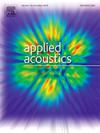Broaden noise reduction range in low frequency by a HR + MPP structure based on impedance matching method
IF 3.4
2区 物理与天体物理
Q1 ACOUSTICS
引用次数: 0
Abstract
Broadening the noise reduction range in low frequency has always been an important problem in the research of acoustic metamaterials. Traditional muffler like Helmholtz resonance cavities (HR) only have high absorption coefficient in its resonant frequency. By designing multi-layer or gradient air cavities, the range of frequency broadened is still limited. As is well known, microperforated plate (MPP) has a wide sound absorption frequency in the middle and low frequency. Taking advantage of the physical property of HR and MPP structure, we designed a composite structure by the method of surface impedance matching. Based on the noise reduction coefficient higher than 0.9, this structure realized a 967 Hz width noise reduction in the frequency below 1000 Hz. More than twice as the multi cavity HR structure we researched before. It is demonstrated that, by the impedance matching method, there is almost no reflection in the contact surface between HR and MPP. Therefore, the low resonant frequency and relatively medium frequency can be well absorbed in HR and MPP structures respectively.
求助全文
约1分钟内获得全文
求助全文
来源期刊

Applied Acoustics
物理-声学
CiteScore
7.40
自引率
11.80%
发文量
618
审稿时长
7.5 months
期刊介绍:
Since its launch in 1968, Applied Acoustics has been publishing high quality research papers providing state-of-the-art coverage of research findings for engineers and scientists involved in applications of acoustics in the widest sense.
Applied Acoustics looks not only at recent developments in the understanding of acoustics but also at ways of exploiting that understanding. The Journal aims to encourage the exchange of practical experience through publication and in so doing creates a fund of technological information that can be used for solving related problems. The presentation of information in graphical or tabular form is especially encouraged. If a report of a mathematical development is a necessary part of a paper it is important to ensure that it is there only as an integral part of a practical solution to a problem and is supported by data. Applied Acoustics encourages the exchange of practical experience in the following ways: • Complete Papers • Short Technical Notes • Review Articles; and thereby provides a wealth of technological information that can be used to solve related problems.
Manuscripts that address all fields of applications of acoustics ranging from medicine and NDT to the environment and buildings are welcome.
 求助内容:
求助内容: 应助结果提醒方式:
应助结果提醒方式:


